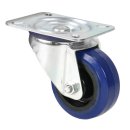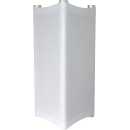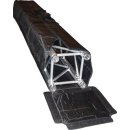Stage Equipment
Comprehensive Guide to Stage and Truss Systems for Advanced Event Planning
Stage and truss systems are foundational to any high-quality event setup, providing the structure and support needed for sound, lighting, and other technical equipment. Whether you’re managing a corporate event, wedding, or large concert, understanding the intricacies of stage and truss rental is critical to creating a safe and aesthetically pleasing environment. In this guide, we delve into the technical aspects of stage and truss systems, including their setup, safety standards, and best practices for maintaining structural integrity throughout your event.
Understanding the Differences Between Stages and Truss Systems
While stages and trusses are often used together in events, they serve very different functions. A stage provides the platform for performances or presentations, while the truss system acts as the backbone for suspending lighting, audio, and visual equipment. Choosing the right stage and truss system for your event will depend on the specific technical requirements, such as load-bearing capacity and height restrictions. For instance, a mobile stage and truss system is ideal for outdoor festivals due to its versatility and ease of setup, whereas larger, fixed systems might be more appropriate for concerts with heavy equipment and complex lighting rigs.
The construction of trusses is particularly important. Typically made from aluminum or steel, trusses are engineered to bear significant loads while maintaining flexibility in design. The most common truss configurations include pre-rigged systems, which allow for rapid deployment, and modular systems that can be tailored to unique event requirements. Advanced users often opt for customizable truss solutions, which allow for greater design flexibility and improved visual impact.
Technical Considerations for Choosing the Right Stage and Truss
When selecting the appropriate stage and truss for an event, there are several technical factors to consider. The weight of the equipment, the size of the venue, and the number of attendees all play a role in determining the type of stage and truss system that will work best. For example, the load-bearing capacity of a truss is critical when dealing with large amounts of lighting and sound equipment. Trusses are often rated for specific weight limits, and exceeding these limits can result in structural failure.
The height of the stage is another critical factor. For corporate events or smaller indoor venues, a lower stage height may be sufficient, while large concerts or outdoor festivals typically require taller stages to ensure clear visibility for all attendees. The selection of truss systems should also account for the height at which lighting and sound equipment will be suspended. A mobile stage and truss system may offer the flexibility needed for outdoor events but must be designed to withstand wind and other environmental factors.
Another crucial aspect is the type of truss. Different types of trusses—such as box truss, triangular truss, and ladder truss—offer various strengths and configurations depending on the load requirements and visual design of the event. Customizable truss solutions allow event planners to build unique setups that enhance the aesthetic appeal while maintaining safety and stability.
Ensuring Safety and Compliance with Stage and Truss Systems
Safety should be a top priority when setting up any stage and truss system. Stage and truss safety standards are designed to ensure that the structures can safely support the equipment and personnel during the event. Key safety standards include ensuring proper weight distribution across the truss system, securely anchoring trusses and stages, and conducting load tests before the event to verify structural integrity.
In addition to adhering to local building codes, event organizers must also comply with industry standards set by organizations such as the Entertainment Services and Technology Association (ESTA). These standards cover everything from the materials used in trusses to the installation procedures for both indoor and outdoor events. Using a certified stage and truss system helps guarantee that your event meets these rigorous safety standards.
Proper assembly of the truss is another critical element of safety. Trusses should be assembled by experienced professionals who understand the technical requirements of each component. Misalignment or improper assembly can compromise the entire structure, increasing the risk of collapse. For advanced users, following detailed truss assembly guides and utilizing appropriate safety gear, such as harnesses and helmets, is essential for avoiding accidents during the setup process.
Cost Considerations: Renting vs. Purchasing Stage and Truss Systems
One of the key decisions in event planning is whether to rent or purchase a stage and truss system. For one-off events or smaller gatherings, stage and truss rental is often the most cost-effective solution. Rental companies typically offer a range of options, from basic setups to fully customized systems, and handle all aspects of delivery, setup, and teardown.
However, for event companies that frequently host large-scale events, purchasing a stage and truss system can be a more cost-effective long-term investment. The upfront costs may be significant, but owning the equipment provides greater control over the setup process and allows for full customization. Additionally, maintaining your own truss system ensures that it is properly cared for, reducing the risk of malfunction during an event.
When considering rental costs, factors such as event duration, location, and equipment type will impact the overall price. For example, a mobile stage and truss system designed for an outdoor festival may come at a premium due to its specialized design and the logistical challenges associated with outdoor events.
Maintenance and Longevity of Stage and Truss Systems
Proper maintenance is essential for ensuring the longevity and safety of stage and truss systems. Regular inspections should be conducted to check for wear and tear, particularly on joints and connection points. Corrosion, cracks, or dents in trusses can significantly reduce their load-bearing capacity and must be addressed immediately.
Many event professionals invest in customizable truss solutions to extend the lifespan of their systems. Modular trusses can be easily reconfigured and repaired, making them a cost-effective option for long-term use. Additionally, using protective coatings or storage solutions can help prevent damage during transport and storage.
Routine maintenance also includes testing the structural integrity of trusses before each event. Load testing is a standard practice in the industry, ensuring that the truss system can handle the weight of lighting, sound, and other equipment without risk of collapse.
Conclusion
Whether you’re planning a corporate event, wedding, or large-scale concert, understanding the technical aspects of stage and truss systems is crucial for ensuring a successful and safe event. From choosing the right mobile stage and truss system to adhering to stringent safety standards, advanced users must take every factor into consideration. By investing in high-quality, customizable truss solutions, you can not only enhance the visual impact of your event but also guarantee the safety and longevity of your equipment.
For advanced event planners, the decision to rent or purchase a stage and truss system will depend on your long-term needs, budget, and the specific requirements of each event. By carefully considering all of these factors, you can create an event setup that is both visually striking and structurally sound.







